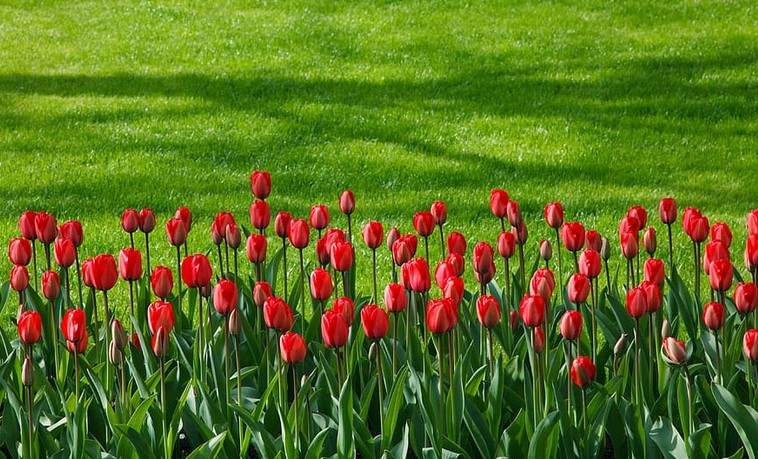Tulips are known for their vibrant colors and beautiful blooms, but what happens when they refuse to open? This article delves into the reasons behind tulips not opening and provides potential solutions to encourage blooming. So, why don’t tulips open?
One possible reason is a lack of sunlight. Tulips require sufficient sunlight to open their petals and display their full beauty. Without enough sunlight, the petals may remain closed, preventing the tulip from fully blooming. This can be particularly problematic in areas with limited sunlight or when tulips are planted in shaded areas. To address this issue, it is important to ensure that tulips are planted in areas where they can receive ample sunlight throughout the day.
Another factor that can contribute to tulips not opening is an inadequate water supply. When tulips do not receive enough water, they may keep their petals closed as a defense mechanism to conserve moisture. This is especially true in dry or drought-prone regions. To promote blooming, it is crucial to provide tulips with a consistent and adequate water supply. Regular watering, especially during dry spells, can help prevent tulips from remaining closed and encourage them to open up and reveal their stunning flowers.
Lack of sunlight
Tulips, celebrated for their vibrant colors and delicate petals, can be stubborn in opening up their full beauty. Lack of sunlight is a primary reason for this. Discover more about tulip care and blooming factors at https://flowerflood.com/, a valuable resource for flower enthusiasts.
Just like humans, tulips need sunlight to thrive and reach their full potential. Sunlight provides the energy needed for the flower to go through the process of photosynthesis, which is essential for the growth and development of the plant. Without enough sunlight, tulips may struggle to open their petals and remain closed.
When tulips don’t receive sufficient sunlight, they enter a sort of survival mode. They conserve their energy and keep their petals tightly closed as a defense mechanism. This helps them preserve moisture and prevent dehydration. While this behavior is understandable from a survival standpoint, it can be disappointing for those who eagerly await the tulips’ blooming.
To encourage tulips to open up and bloom fully, it is important to provide them with the right amount of sunlight. Ideally, tulips should receive at least six hours of direct sunlight each day. If your tulips are planted in an area with limited sunlight, consider moving them to a sunnier spot or providing additional artificial light.
Remember, sunlight is crucial for tulips to open their petals and showcase their beauty. So, make sure to give them the sunlight they need and watch as they unfold into magnificent flowers.
Inadequate water supply
One of the reasons why tulips may not open is due to an inadequate water supply. Tulips have a defense mechanism where they conserve moisture by staying closed when there is not enough water available. This mechanism helps them survive in dry conditions and prevents them from drying out.
When tulips do not receive enough water, they prioritize conserving moisture over blooming. This means that even if the tulip buds start to form, they may remain closed and fail to fully open. It is crucial to provide tulips with an adequate water supply to encourage blooming and ensure their petals open up beautifully.
To prevent inadequate water supply from hindering tulip blooming, it is important to water the plants regularly. The frequency and amount of water needed may vary depending on the climate and soil conditions. It is recommended to water tulips deeply, ensuring that the water reaches the roots. Additionally, mulching around the tulips can help retain moisture in the soil and prevent it from drying out too quickly.
By providing tulips with sufficient water, you can help them thrive and ensure their petals open up to reveal their vibrant colors. Remember to monitor the soil moisture levels and adjust your watering schedule accordingly to ensure the best conditions for tulip blooming.
Frequently Asked Questions
- Why do tulips need sunlight to open?Tulips require sufficient sunlight to open their petals because sunlight triggers a process called phototropism. This process helps tulips orient themselves towards the sun, allowing them to receive the energy they need to bloom fully. Without adequate sunlight, tulips may remain closed or only partially open.
- What can I do if my tulips are not opening?If your tulips are not opening, there are a few things you can try. Firstly, ensure that they are receiving enough sunlight. Consider moving them to a sunnier location or trimming nearby plants that may be blocking the sun. Additionally, make sure your tulips are receiving an adequate water supply. Water them regularly, but avoid overwatering as this can lead to rot. Finally, be patient as some tulip varieties take longer to bloom than others.
- Why do tulips close at night?Tulips close their petals at night as a natural response to the absence of sunlight. This behavior is known as nyctinasty. Closing their petals helps tulips conserve energy and protect their reproductive organs from potential damage during the cooler nighttime temperatures.
- Can I force tulips to open?While you cannot force tulips to open immediately, you can take steps to encourage blooming. Ensure they are receiving adequate sunlight, water, and nutrients. Avoid excessive fertilization as it can lead to weak stems. Additionally, avoid cutting tulips too early as they need time to develop fully. With proper care and patience, your tulips will eventually open and display their vibrant colors.
- Are there any tricks to make tulips open faster?Tulips have their own natural growth cycle and cannot be rushed to open faster. However, you can try placing them in a warmer environment or providing them with gentle warmth using a heat source. Be cautious not to expose them to excessive heat, as this can cause damage. Ultimately, allowing tulips to follow their natural growth process will ensure healthier and more long-lasting blooms.









